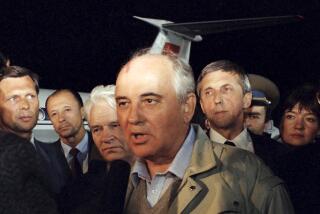COMMUNISM : Lenin’s Last Years: The Toothless Lion : Lessons in grade school arithmetic and use of a toothbrush proved the Soviet leader’s wretched mortality.
- Share via
MOSCOW — With about two years left in his stormy existence, the Leader of World Revolution didn’t know how to use a toothbrush.
His wife tried to teach him to speak again, using handwritten flash cards with childish phrases like “Papa is carrying hay,” or even single syllables like “ma.”
In a blue-covered copy book, he relearned grade-school arithmetic (“23 x 4 = 92”). Sometime in August, 1923, this author of “What Is To Be Done?” and other polemical masterworks struggled to scrawl this with a pencil: “There was a kitty the children were playing with. The kitty suddenly disappeared. . . .”
One of the most hackneyed slogans in Communist days was “Lenin Lived, Lenin Lives, Lenin Will Live!” But Vladimir Ilych Lenin, 1870-1924, it is now obvious, was desperately, wretchedly mortal at the end of his life.
In the museum on Red Square that once was a virtual shrine to Lenin, documents kept hidden in the Communist Party’s Central Archives for almost three-quarters of a century are now on display, and they cast a shocking light on the revolutionary once treated as a virtual deity.
“It is the breaking of a taboo,” acknowledges Tatyana G. Koloskova, the Lenin Central Museum’s deputy director. “We never here used to refer to Lenin as being human, or having died. He was always ‘Lenin, the leader,’ rather than ‘Ulyanov (his real name), the man.’ ”
It is the photographs that instantly stun the visitor to Rooms 16 and 17. They do not show Lenin swaggering or haranguing the workers, or with an impish smile, as familiar propaganda images do.
In one of these new pictures, Lenin, haggard and dazed, his mustache unkempt, sits on a bed after a stroke in March, 1923--his third--that deprived him of his ability to speak. In another haunting image, taken that same summer, he has a gimlet-eyed, agony-filled stare as he sits, sunk in a wheelchair with his younger sister, Maria Ulyanova, and a physician at his side.
Before he died at 53 on Jan. 21, 1924, Lenin had four strokes. Even before the first, he was feeling so exhausted that, according to a letter written by his sister and now on display, Lenin asked Josef Stalin to give him poison if he became paralyzed.
Why Stalin?
He was “devoid of sentiment,” Maria Ulyanova explains.
The first stroke occurred on May 25, 1922. It so devastated Lenin’s cerebral capacities that four days later, “when he was given a toothbrush, he didn’t know how to use it,” wrote Dr. A. M. Kozhevnikov, the Kremlin leader’s physician.
Lucidity and the old gift for self-expression returned at times; Lenin addressed a meeting of the Communist International in four languages that October and returned to chair some sessions of the Council of People’s Commissars.
But the declassified documents make clear that, on the whole, the man who masterminded the seizure of power in the world’s largest country finished his days as a figurehead to be carted from one meeting to the next.
“They take me for a fool,” Lenin wept one June day in 1922, his doctor wrote.
Meanwhile, Lenin’s high-ranking party comrades--Stalin, Leon D. Trotsky, Nikolai I. Bukharin, Lev B. Kamenev and others--were jockeying for power, even as they ritually professed respect for their incapacitated leader. They kept him isolated and out of politics, ostensibly for the sake of his health.
“Lenin died alone,” Koloskova said. “They didn’t care about Ulyanov--all they cared about was Lenin the symbol.”
More to Read
Sign up for Essential California
The most important California stories and recommendations in your inbox every morning.
You may occasionally receive promotional content from the Los Angeles Times.









